Q&A with NY Fed chief: Full economic recovery on LI will take years

A full economic recovery from the coronavirus pandemic and shutdown of nonessential activity will take years, not months, a top Federal Reserve official said Thursday.
John C. Williams, president of the Federal Reserve Bank of New York, said the virus’ continued spread and number of new diagnoses will dictate consumer spending, which is crucial to the economy bouncing back on Long Island and in the metropolitan area. He predicted June’s economic indicators will show marked improvement from May.
“I expect the second half of this year to be one of pretty solid [economic] growth, a pretty strong rebound given how sharp the decline was,” he said in an interview. “But still by the end of the year, I don’t think we’ll be back anywhere near normal in terms of jobs or incomes.”
Williams spoke to Newsday on the second day of his two-day virtual get-acquainted tour of Long Island. An economist, he sits on the Fed’s interest-rate-setting Federal Open Market Committee. His comments have been edited for clarity and length.
What's the forecast for the Long Island economy?
“The [economic] fundamentals of the region are really strong. I don’t think there’s any issue about that…Hopefully, we’re hitting bottom and we’ll see in the second half of the year, the economy start coming back…One thing we did learn in the great recession is it can take time for people to kind of feel comfortable…This is one of the reasons I think it may take a couple of years or a few years to get back to full strength.”
What factors will affect the recovery?

Construction workers are back on the job in Glenwood Landing during Phase 1 of Long Island's reopening on Wednesday. Credit: Newsday/J. Conrad Williams Jr.
“There is a very highly educated workforce. Long Island is near a key center of financial, commerce and tourism in New York City…There's just a lot of positives that were true in February and are still true today and will be true in the next couple of years.” Restaurants, hotels, stores and tourism destinations “will come back but the hard part is how long it takes is driven by what happens with the virus.”
How will the tourism and hospitality industry fare?
“Some sectors that New York’s and Long Island’s economy rely on are going to take more time. Tourism, travel, hospitality, entertainment, getting people to come back to the museums, the shows, the beaches, and be able to do that in a normal way, it’s going to take more than just a few months.”
Will unemployment get worse?
“We're at its worst point. Hopefully over the next six months or so, we’re going to see improvements; some [industry] areas, it's going to take longer.”
What will we see in the LI housing market?
The Federal Reserve “lowered interest rates, so that will pass through to the buyers, which should support a rebound in the housing market…The market has kind of digested the pandemic [and] I expect interest rates on mortgages will continue to come down…The conditions for the housing market here haven’t fundamentally changed.”
Will the commuting culture change?
“It’s an open question whether people and employers rethink that. It could mean that more employers move satellite offices out to Long Island…People are talking more about telework, where people don’t have to get on a train and go into the city…So, I do think there’s going to be some structural changes around how we work and where we work.”
What is the Fed doing to help businesses?
The Federal Reserve’s “Main Street lending program is in the final stages of preparation; we’re hoping to start lending money in the next few weeks. I wouldn’t say we’re focused on the smallest businesses, but small- and medium-size businesses that employ people. It will cover a lot of businesses in this region who find they can’t borrow easily in the market from banks. We don’t want them to fail or go into bankruptcy.”
What about local governments?
The Federal Reserve’s “municipal liquidity facility is about providing credit to state and local governments…Local governments are seeing huge revenue declines and they're the ones providing the police, the fire and other essential services. They cannot run big deficits for long…The fact that the markets understand that [the Fed] is backstopping has meant the interest rates for local governments who are borrowing have come way down. And that lowers the burden on the taxpayer.”
How is this recession different?
“This is nothing like the recessions that we’ve seen in the post-World War II period…This isn’t an issue with the banks or an issue with the housing market or the stock market. This is really a health crisis that has spilled over into the economy as restrictions were put on economic activity."
Any final thoughts?
“This is going to pass. The economy will be coming back. Jobs will be returning. Consumers are going to come back and they're going to want to buy the things that people love…We're doing everything we can to help get the economy back on track and make sure that it gets back to the position it was in just a few months ago: really strong, inclusive growth.”

